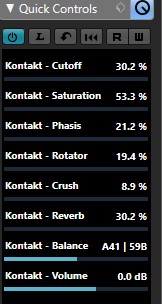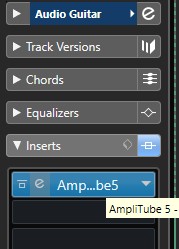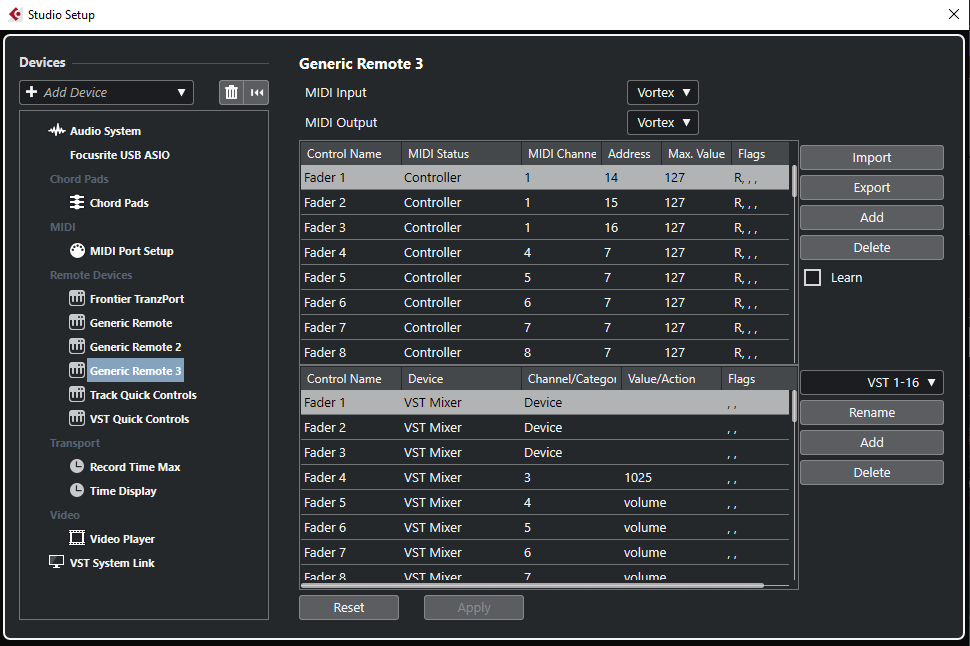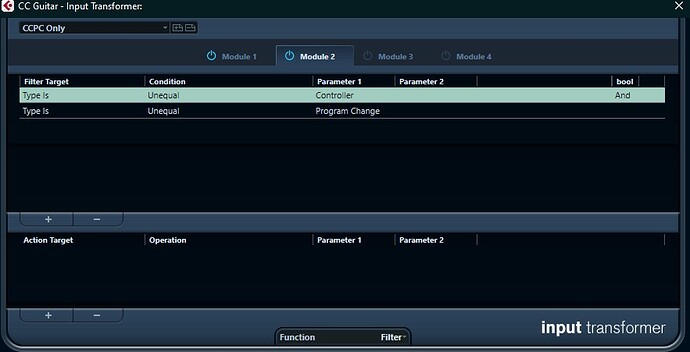I’m able to apply an effect and add some controls to the eight quick control slots. I can operate the sliders in quick controls and see the knobs turn on the vst effect. I can read and write automation successfully. When I operate a knob on either of my two controllers (Behringer BCF2000 and Alesis Vortex) I can see that midi is coming in by looking at the display in the bottom right of the cubase screen. However, I am not able to use the knobs to control the knobs on the vst effect. I have gone into studio setup and clicked the “learn” checkbox and selected a line and then turned a knob on the controller both in generic remote and VST quick controls. The midi input and output recognizes the controller at the top of the screen successfully. My intuition tells me I’m doing something wrong in the Studio Setup area, but I can’t figure out what. Any ideas?
Hi,
There are 2 steps. The 1st step is the one, you do. This is the assignment the MIDI Message to the Quick Control controller. The 2nd step is to assign the Track Quick Control to the dedicated tracks’ parameter. To do so, right-click the parameter in the plug-ins’ GUI and select Add “parameter name” to Quick Control Slot… X.
Martin:
Thank you. Here are the quickcontrols:

And as you can see, right clicking brings up a shortcut menu on a steinberg plugin.

However, the other 3rd party plugin (Ohmforce Predatohm) does not bring up a shortcut menu.
But the real problem is that by rotating a knob on the controller it doesn’t move a knob on the plugin. But midi is getting through, as shown below:

Maybe something is not right in the Studio setup. If you see something wrong in the two screens below please let me know. thanks!
Is this a game? It feels like a CS interview question, or a spot the difference game.
Which feel exactly the same.
It’s weird, but not functionally a problem to have Address 7 as a fader control spread out over different channels. Also 7 IS main volume, but it isn’t typically mapped to faders.
VSTQC 3 & 4 are set to the same CC
You are using the same Hardware (or port) for both the Generic Remote and the VSTQCs and there is overlap between the two.
It’s okay to use the same port (or hardware) for both Generic Remote and the VSTQCs and TQCs, but you need to make sure the CC addresses do not overlap. (Don’t use the same CC address twice). But I have seen that done intentionally.
I typically set these up all on channel 15 and 16 and make sure that there isn’t any clash with the rest of the MIDI, and you can take those controllers out of ALL, by unchecking the checkbox in MIDI Port Setup. But if you put them on different channels you don’t have to do that.
As an aside, keeping channels separated is really important with MIDI. Some people just use Ports, and loose out on a lot of possibilities. Ableton Live for instance treats MIDI this way, and converts everything to Channel 1. I find it practically unusable because of this.
I put Control Macro triggers on Notes of Channels 15 and 16. CCs for control surface and QCs also on 15 and 16.
Drum Sequence triggers on 11 and Drums on 10 (that’s standard)
Any further triggers for clips, loops and the like on 14, leaving 12 and 13 for testing or separate implementations.
Left hand and direct CCs , and foot controllers on channel 1. Right hand on Channel 2. Sometimes these get split with Left and Right also having Channels 3 and 4.
Channel 9 is also special it’s where I put expressions. Which I also put on a different midi track because that’s how I have always done it. It works, but I could move that to Channel 1 now, and use expression maps or leave it that way and still use expression maps. Having expressions on a different track is handy because you can pull it up in the editor together with another track, without the notes getting in the way.
That leaves Channels 5-8 completely unused. But they could be available for additional musicians. All it takes is a quick translator, and MIDI channel assignments.
There is plenty of room using All Midi Inputs and spreading things out through channels. This way, when mobile, I can use the same control surface for playing notes as controlling the DAW etc.
That was a long and personal aside, but it shows how you can think about the setup.
The next thing to consider is if you really need Quick Controls. If you always make a MIDI CC track for every instrument or audio channel, then you can “Learn MIDI” for the knobs etc. directly, and never have to worry about only having 8 which overlap with other instruments. Not only that, but you can also have all of the CC of a performance in one place and easily accessible to rout to whatever other instrument, and those CCs can be active for two instruments at the same time, controlling different parameters. This can be done by filtering the MIDI to that track to take out anything but CCs. Quick controls have track specific focus, which is very limiting when you separate a signal chain between different tracks.
You get a lot more from routing MIDI correctly.
Thanks for the advice. I will go through your comments carefully. I’m a beginner so it will take me awhile. But you have to start somewhere!
I have given your comments some study. I can see where having a limit of 8 quickcontrols might be constrictive. So I would like to try your suggestion of trying “learn midi” for knobs (on VST effects) directly. However, I haven’t been able to figure out how to do that. If you are willing to walk me through those steps that would be most appreciated. It might not be as easy as you think, since you’ll have to get down on my level, which is a low level indeed where you should assume I don’t know anything at all. Just pretend you are talking to a child, as Sarris said to captain Nesmith in “Galaxy Quest”. Thanks in advance.
John,
First, you don’t have to set up an extra MIDI track, when it is already a MIDI instrument.
Second, you should set up quick controls because NI and Steinberg both have automatic assignment to those.
Example:

So what controller are you using, and do you know how to program it for what knobs or sliders send which CCs?
Next -
How to set up a Midi Channel to send the controls.
In this example I have made two tracks, and audio track for direct guitar input and a MIDI track for the CCs

The Guitar comes in from my iRig on the laptop which is named Guitar -] 1

I inserted AmpliTube 5 on the Guitar Audio track

I have routed the output of the MIDI from the CC Guitar track to Amplitube (You get 4 more in the sends, but I did this one the easy way with the direct.)

See that Orange arrow at the top right, it won’t be orange until the next step.

Set up a filter for the MIDI track.
Make sure the little power button at the top is selected or it does nothing. This will ensure that only the CCs and Program Changes from Channel 1 make it through.
(Sometimes this is problematic… looking at you Steiny. In that case put the same two filters on MIDI insert “transformer”. You can do it all as one in both cases, but I have presets saved, so… and in the transformer it is also called “Delete” instead of filter. The down side is you will see MIDI activity. Also make sure if you do it that way to make it write by clicking the little red button on each transformer. You likely won’t need to do this. The local filter usually works.)
Here is what that would look like anyway:
And here is where you could use a send:

I like to put a monitor on while I am setting it up, just to make sure the signal is going through. You could just put this monitor on the inserts if you used the direct routing shown above.

Now make sure that “monitor” is selected on both tracks.

Open the insert and right click and select “midi learn” or “learn ” and move the knob or slider that you want to use to control it.
Note: for some reason, at times, you have to toggle the “monitor” state of the midi track on and off to get it to work, but I have never had difficulty once it is learned.
I hope this helps.
Thank you sir. Yours was a very nicely done post with excellent screenshots. I will study it in detail tomorrow and try to apply it. I think your post is likely to help a lot more people than just myself. After your previous post I was able to successfully get the all the controls on my Behringer BCF2000 including sliders, knobs, and latched buttons to control multiple plugins through the quickcontrols, as well as record and playback the automation. So that is some good progress. Part of my problem was configuring “VST quick controls” instead of “track quick controls” in studio setup. Now if I can just figure out how to get the midi back to the controller to utilize the automated faders.
Opps, I should have caught that one. I remember being confused about “track” and “quick” at one point.
I have not tried to set up a BCF200, and I haven’t ever got automated faders to work other than Mackie , which just works. But I have got lights to come on when I have moved non automated faders. The way to do that is to go to the top of the Generic Remote setting and select send as well as receive.
That controller has been around for a very long time. I bet someone has a mapping for it. Here is a help file from long ago, but likely still valid:
https://recording.de/attachments/cubase-sx-2-2-1-06-bcf-instructions-pdf.13112/
It was going great . . . until I realized that with Cubase Elements 11 you don’t get any MIDI sends or inserts! Maybe when version 12 comes out I’ll look into upgrading. In the meantime do you think there is a possible workaround that isn’t a brain transplant?
Ah! okay, that changes things a bit. You would do well to set up VST quick controls.
However, you can still set the Port on a MIDI track, and you can still connect the device with the CC’s to a MIDI Track, and you can still route the output of that MIDI tack. It isn’t that limiting.
I was under the impression that you were transitioning from another Professional DAW, my apologies. Instead, why don’t we discuss what you will be doing, and what kind of music you will be creating. Will you be using virtual and or bass guitar amps? Focusing primarily on Electronic music? Composing? And if so to what extent is your composition intent?
Instead of nerding out (which I love to do) let’s focus on getting the direct needs you have right now, and get you creating music. When you come from one DAW to another, you have a certain workflow that you already use, and you want to recreate that as best you can. But as you use a new DAW you find that there are new possibilities and restrictions.
For now, let’s focus on the quick controls and then worry about special learned controls as you need them. You will have a pretty good guide above when you find that 8 controls are not enough.
So what hardware will you be using that has controls on it? Did you find the link above for the Behringer helpful?
Hi,
You can upgrade already, if you need the feature. You would get Cubase 12 Pro for free thanks to the Steinberg Frace Period, once it’s out.
Thank you so much. This video is very helpful for setting up remote control for knobs and sliders for both vst plugins and vsti instruments through quick controls. All that is working well. Still would be nice to figure out how to do that outside of quick controls so wouldn’t be limited to 8 slots, but that will be a reason to upgrade out of cubase elements.
Thanks for the tip. After looking at the Cubase 12 info available it isn’t clear to me whether you’ll be able to use VST 2 plugsins on Windows machines. Or is it VST 3 only? Does anyone have any information on that?
The reality is, I got a bit nerded out, and I applogize for that. It’s my standard way of doing it for two reasons. First, I use amp sims for guitar and bass with a flour midi controller, and I just have to have it set up just like my old pedalboard. You get older and you get stuck in your ways with some things. And, since I have to have my interaction with any given signal chain the same, I always have a CC track for every signal chain whether it is MIDI or not. I never need more than 8 controls at once, and usually not even that many per instrument at a time. Most people these days use MIDI logic-style and only ever focus on one signal chain at a time. I don’t do that either, but I like to nerd out on it just as much as I like making music, so you really should focus on your particular use case, what do you really need? I really wouldn’t worry about it.
What I would worry about though is VST2 and VST3. I do not own a plugin or instrument that does not have a VST3 version. I haven’t seen one that was VST2 only in nearly a decade. If you hear anyone grousing about VST2 going away, then you should also be concerned about your Pentium 2 Core, or your iMac 8i.
VST is Steinberg technology, and if they stop supporting VST2, then everyone else will have to follow.
Just like the Windows OS that you would have had back then is no longer supported!!! Or the Mac OS.
Rewire was taken out of Ableton Live 11 (*), and will likely not be in C12, because Rewire is no longer supported. Software has an end of life.
It is very unlikely that you have purchased any VST2 only plugins, and it is highly unlikely that you ever will again, or that anyone will be selling them, Any other DAW you find will also stop supporting VST2 very soon, if they haven’t already.
It’s a non issue for everyone but a very few who are tied to very old plugins, and either do not want to upgrade those plugins, or the company has gone out of business.







